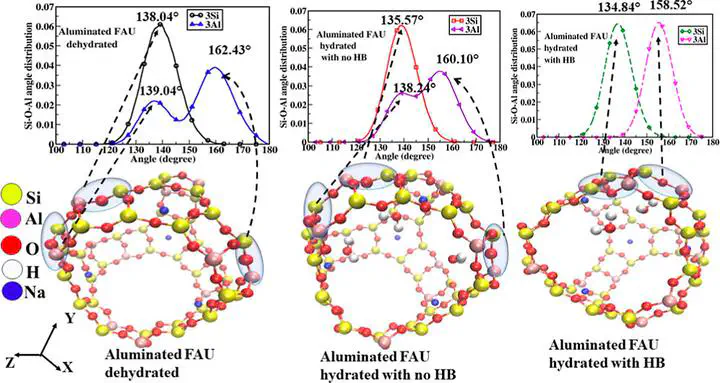Hydrogen Bond Dynamics in Siliceous and Aluminated Faujasite: Comparison with Bulk Water

Abstract
Molecular dynamics simulation has been carried out for water confined to siliceous as well as aluminated faujasite (FAU). Results were compared with bulk water. Our study shows that it is Na(1) [positioned at 32e (Table 227 in reference International tables for crystallography, 1983, vol. 1 x = 0.2345(2))] rather than Na(2) (at 32e x = 0.0507(4)) and Na(3) (at 16c, x = 0.00) in aluminated FAU which interacts strongly with water. Distribution of the center of mass of water from the center of the α-cage to the peripheral region of aluminated FAU shows two distinct peaks centered at 4.7 and 5.5 Å unlike water in siliceous FAU where a single peak appears at a distance of 4.1 Å from the center of the α-cage. Water confined to aluminated FAU performs large amplitude angular jump at time intervals of 10 ps or more as can be seen by the two distinct peaks appearing in the van Hove correlation function. The presence of water within the zeolite and the hydrogen bonding of water to the oxygen of the zeolite are seen to lead to significant structural changes in the zeolite. There are small changes in the bond length of the Si–O/Al–O. The O–Si–O and Si–O–(Si/Al) angles are seen to change significantly. Model calculations on Si(Al)3Si and Si(Al)1Si3 (no Si(Al)2Si2 was seen for Si/Al = 3.0) showed that the variation of the number of OAl atoms attached to the Si of aluminated FAU also leads to the bimodal distribution of ∠Si–O–Al where two peak maxima appear at 140° and 160°. The confinement of water reduces the decay of the second-order orientational correlation function of the dipole moment vector, H–H vector, and O–H vector of water. Symmetric hydrogen-bond formation between water and OSi of aluminated FAU leads to the bimodal distribution of ∠O–Si–O where two peaks are centered at 107° and 125°.